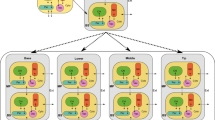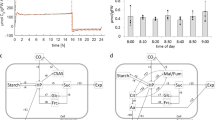Abstract
A computer model written for whole leaves and described in the preceding publication (Slovik et al. 1992, this volume) has been developed for calculating the distribution and fluxes of weak acids or bases amongst different leaf tissues and their compartments, considering membrane transport, transpiration-driven mass transport, symplasmic and apoplasmic diffusion, and metabolic turnover rates in specified compartments. The model is used to analyse flux equilibria and the transport behaviour of the phytohormone abscisic acid (ABA) in unstressed and stressed leaves. We compare experimental data of unstressed Valerianella locusta L. leaves and expectations based on the detailed analysis of the data. (i) The mean daily influx of ABA into the leaf lamina via the xylem sap is about 10 nmol · m−2 · day−1. It is balanced by the sum of an export of ABA via the phloem sap (0.7%), possibly also by a basipetal ABA transport in the petiole parenchyma of young leaves (up to 18%), by an irreversible conjugation of ABA (0.4–4%) and by net degradation of ABA in the leaf lamina (80–95%). (ii) The estimated kinetic parameters of this net degradation are for the mesophyll apoplasm: apparent K m = 3.7 nM and V max = 12.9 nmol · m−3 · s−1, or for the mesophyll cytosol: apparent K m = 8.1 nM and V max = 32.3 nmol · m−3 · s−1. (iii) The dynamic ABA concentration in the phloem sap of Valerianella is 2.8 nM. This is only 5.5% of the static ABA equilibrium concentration in excised leaves or 70% of the ABA concentration in the mesophyll apoplasm, and it equilibrates within a few hours after source concentrations in the mesophyll apoplasm are changed under stress. Thus, the phloem sap is a flexible medium for transporting ‘new phytohormone information’ from the lamina to the shoot and roots, (iv) Measured compartmental ABA concentrations are close to calculated equilibrium concentrations in unstressed leaves. We conclude that model calculations are close to reality, (v) pH gradients within the apoplasm influence the apoplasmic distribution of ABA. Its concentration is maximally about twofold higher in guard-cell walls relative to the mesophyll apoplasm. (vi) Unexpectedly, all compartmental equilibrium concentrations of ABA in the leaf lamina depend on plasmalemma conductances for undissociated ABA and on the transport properties of the plasmodesmata. This is a consequence of the cyclic diffusion pathway: mesophyll cytosol — mesophyll plasmalemma — mesophyll apoplasm — epidermal apoplasm — epidermal plasmalemma — epidermal cytosol — plasmodesmata — mesophyll cytosol (in this direction), if there are different apoplasmic or cytosolic pH values in both tissues. The cyclisation rate is 42 fmol · s−1 · m−2 leaf area, which corresponds to a turnover time = 11.0 h for the total ABA content within the leaf lamina. A decrease of the epidermal plasmalemma conductance by 90% yields a threefold ABA concentration in the guard-cell free space, (vii) Compartmental relaxation-time coefficients are estimated and summarised for all leaf tissues and its major compartments. They range from 1.5 min for chloroplasts up to 3.3 d for mesophyll vacuoles, (viii) The highest ABA concentration, which can be expected in any leaf compartment, is 7 mM in the guard-cell cytoplasm of certain plant species, (ix) We employed circadian changes (equal day + night, 12 h each = equinoctium) of the stromal pH ± 0.3 in C3 plants, and for Crassulacean acid metabolism (CAM) plants, additionally, vacuolar pH ± 2.5 changes, and calculated the consequences for ABA redistribution within the lamina. In plants of both photosynthesis types, the ABA concentration in guard-cell walls is only 1.5 times higher in the night relative to the day. We conclude that stomata may not be regulated by ABA in a night-day regime. The influence of the extreme vacuolar pH changes on ABA distribution is small in CAM plants for two reasons: the ABA content in CAM mesophyll vacuoles is low (maximum 2.7% of the total ABA mass per unit leaf area) and there is only a 6.5-fold increase of the mole fraction of undissociated ABA when the the vacuolar pH is lowered from 5.5 to 3.0 (importance of the absolute pKa = 4.75 of ABA).
Similar content being viewed by others
Abbreviations
- ABA:
-
abscisic acid
- CON:
-
ABA conjugates
- HABA:
-
neutral ABA species
References
Baier, M., Hartung, W. (1991) Movement of abscisic acid across the plasmamembrane of phloem elements of Plantago major. J. Plant Physiol. 137, 297–300
Behl, R., Hartung, W. (1986) Movement and compartmentation of abscisic acid in guard cells of Valerianella locusta; effects of osmotic stress, external H+ concentration and fusicoccin. Planta 168, 360–368
Brinckmann, E., Hartung, W., Wartinger, M. (1990) Abscisic acid levels of individual leaf cells. Physiol. Plant. 80, 51–54
Cornish, K., Zeevaart, J.A. (1985) Movement of abscisic acid into the apoplast in response to water stress in Xanthium stmmarium. Plant Physiol. 78, 623–626
Cowan, I.R., Raven, J.A., Hartung, W., Farquhar, G.D. (1982) A possible role for abscisic acid in coupling stomatal conductance and photosynthetic carbon metabolism in leaves. Aust. J. Plant Physiol. 9, 489–498
Daeter, W., Hartung, W. (1990) Compartmentation and transport of abscisic acid in mesophyll cells of intact leaves of Valerianella locusta. J. Plant Physiol. 136, 306–312
Dörffling, K. (1983) Regulation der Stomaapertur — Ein Beispiel für die Bedeutung der Hormonsynthese, Metabolisierung, Kompartimentierung und Interaktion für einen hormonal gesteuerten Prozess. Hohenheimer Arb. 129, 102–120
Dörffling, K., Böttger, M. (1968) Transport von Abscisinsäure in Explantaten, Blattstiel und Internodialsegmenten von Coleus rheneltianus. Planta 80, 299–308
Dörffling, K., Tietz, D., Streich, J., Ludewig, M. (1980) Studies on the role of abscisic acid in stomatal movements. In: Plant growth substances 1979 (Proc. 10th Int. Conf. on Plant Growth Substances, Madison, Wis., USA), pp. 274–285, Skoog, F., ed. Springer, Berlin Heidelberg New York
Gollan, T. (1987) Wechselbeziehungen zwischen Abscisinsäure, Nährstoffhaushalt und pH im Xylemsaft, und ihre Bedeutung für die stomatäre Regulation bei Bodenaustrocknung, Ph.D. thesis, University of Bayreuth, FRG
Heilmann, B., Hartung, W., Gimmler, H. (1980) Redistribution of abscisic acid between chloroplasts and cytoplasm of leaf cells and the permeability of the chloroplast envelope for abscisic acid. Z. Pflanzenphysiol. 97, 67–78
Kaiser, G., Weiler, E.W., Hartung, W. (1985) The intracellular distribution of abscisic acid in mesophyll cells — the role of the vacuole. J. Plant Physiol. 119, 237–245
Lahr, W., Raschke, K. (1988) Abscisic acid contents and concentrations in protoplasts from guard cells and mesophyll cells of Vicia faba L. Planta 173, 528–531
Laisk, A., Pfanz, H., Schramm, M.J., Heber, U. (1988) Sulfur-dioxide fluxes into different cellular compartments of leaves photosynthesizing in a polluted atmosphere. Planta 173, 230–240
Loveys, B.R., Robinson, S.P. (1987) Abscisic acid synthesis and metabolism in barley leaves and protoplasts. Plant Sci. 49, 23–30
Pfanz, H., Dietz, K.J. (1987) A fluorescence method for the determination of the apoplastic proton concentration in intact leaf tissues. J. Plant Physiol. 129, 41–48
Pierce, M., Raschke, K. (1981) Synthesis and metabolism of abscisic acid in detached leaves of Phaseolus vulgaris L. after loss and recovery of turgor. Planta 153, 156–165
Radin, J.W., Hartung, W., Kimball, B.A., Mauney, J.R. (1988) Correlation of stomatal conductance with photosynthetic capacity of cotton only in a CO2-enriched atmosphere: mediation by abscisic acid? Plant Physiol. 88, 1058–1062
Raschke, K. (1975) Simultaneous repuirement of carbon dioxide and abscisic acid for stomatal closing in Xanthium strumarium L. Planta 125, 243–259
Slovik, S., Hartung, W. (1991) Stress-induced redistribution kinetics of ABA in leaves: Model considerations. 14th Int. Conf. on Plant Growth Substances, Amsterdam, July 21–26, 1991, Lectures, in press
Slovik, S., Baier, M., Hartung, W. (1992) Compartmental distribution and redistribution of abscisic acid in intact leaves. I. Mathematical formulation. Planta 187, 14–25
Slovik, S., Hartung, W. (1992) Compartmental distribution and redistribution of abscisic acid in intact leaves. III. Analysis of the stress-signal chain. Planta 187, 37–47
Weiler, E.W. (1980) Radioimmunoassay for the differential and direct analysis of free and conjugated abscisic acid in plant extracts. Planta 148, 262–272
Author information
Authors and Affiliations
Additional information
We are grateful to Professor U. Heber (Lehrstuhl Botanik I, University of Würzburg, FRG) for stimulating discussions. This work has been performed within the research program of the Sonderforschungsbereich 251 (TP 3 and 4) of the University of Würzburg. It has been also supported by the Fonds der Chemischen Industrie.
Rights and permissions
About this article
Cite this article
Slovik, S., Hartung, W. Compartmental distribution and redistribution of abscisic acid in intact leaves. Planta 187, 26–36 (1992). https://doi.org/10.1007/BF00201620
Received:
Accepted:
Issue Date:
DOI: https://doi.org/10.1007/BF00201620




